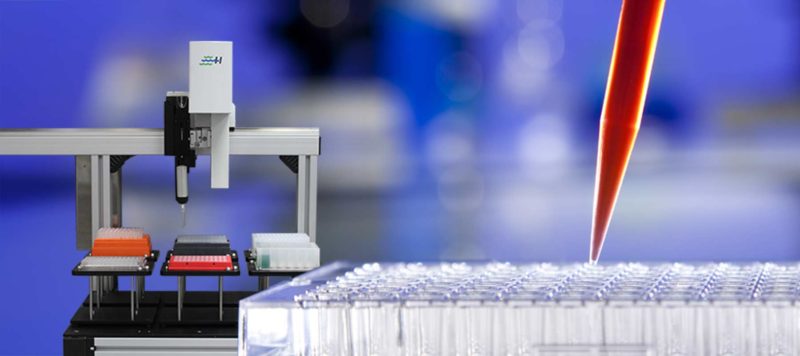No products in the basket.
PartnershipsProducts and SolutionsComponents of a Liquid Handling System
1 August 2022by verulam

In modern science and pharmaceutical laboratories, tiny amounts of liquid must be transferred many times to perform everything from genetic testing to drug screens. As science has improved, the amount of liquid needed for accurate testing has been reduced to low microliter and even nanolitre amounts. Trying to transfer these very small quantities fully and completely by hand is a nearly impossible task. Hence, the need for an automated liquid handling system to transfer these minute quantities precisely and consistently without causing stress or repetitive motion injuries. Read on to learn more about liquid handling and how it can help your lab.
Initial Problems Developing Automated Liquid Handling Robots
The primary difficulty faced by humans and robots in transferring tiny amounts of liquid is two-fold:
- The adhesion of the liquid to the container’s surface makes it difficult, especially when dealing with tiny quantities, to transfer the entire volume.
- The contact angle between the surfaces is important in determining what portion of the liquid will be transferred.
Solving Automated Liquid Handling Problems
Solving the problems with automated liquid handling takes two forms. The first method uses a contact technique where the sample liquid is aspirated into a cannula or disposable pipet tip and then dispensed. Either air-based or positive displacement pipetting techniques that can be done manually are emulated by a liquid handling robot.
While this is the most popular method of transferring small volumes in the microliter range, the sheer number of samples and transfers strongly indicate using automated liquid handling.
The second method is non-contact pipetting accomplished by “pinging” the bottom of a compatible source plate with sound energy causing a controlled droplet to rise up and make contact with an inverted source plate. This is a precise, repeatable method that is perfect for specialized applications that make the high capital acquisition cost worthwhile. Similarly, other non-contact methods can be used for reagent dispensing, with the motive force being a pump, syringe-pump or pressurized bottle with precise valve controls. This form of automatic liquid handling is required to successfully transfer liquids in very small volumes.
Automatic Liquid Handling in the Science Lab
The increasing complexity of experimental design has forced automatic liquid handling to come into its prime. Some of the initial problems with automation have finally been overcome. Issues such as the need for a sophisticated programmer and time to create complex robotic programs made liquid handling systems useful only when necessary. Otherwise, standard pipetting and older transfer techniques were the only options.
With the modernization of robotics and software programs, the expense of acquiring a liquid handling robot has decreased dramatically. Simultaneously, complex software programs have been designed with user-friendly interfaces to allow scientists to maximize automatic liquid handling systems for use in many quite different experimental designs with minimal training and negating the need for an IT specialist on staff.
Automatic Liquid Handling in the Pharmaceutical Industry
In the pharmaceutical industry, studying everything from drug delivery mechanisms to pharmacokinetics in animal cells requires repeated liquid transfers.
For years, a major limitation on pharmaceutical laboratories’ productivity was the time and work involved in executing these complex protocols. Initially, automatic liquid handling was expensive, bulky, and difficult to program, making these systems rare sights in labs.
Now, automatic liquid handling models are affordable, compact with many bench-top models, and easily programmed by the scientists themselves.
Given such a seismic shift in liquid handling systems, it is not unreasonable to expect the discovery and release of new medications to increase rapidly and dramatically thanks to the state of automatic liquid handling.
Contact Verulam Scientific Ltd today to request a consultation, learn more about the line of automatic liquid handling systems, and discover a host of options to improve your laboratory performance and efficiency.
Verulam Scientific Ltd are the UK distributor and service provider for Hudson Robotics. Speak to a member of our technical team at [email protected] or call 01234 381000.
#VerulamScientific #Automation #Innovation #SamplePreparation #LiquidHandling #CustomisedSolutions #SyntheticBiology #HudsonRobotics #AutomatedLaboratoryEquipment #LifeScienceResearch #DrugDiscovery #ClinicalResearch #PharmaceuticalDevelopment #Screening #Proteomics #Genomics




